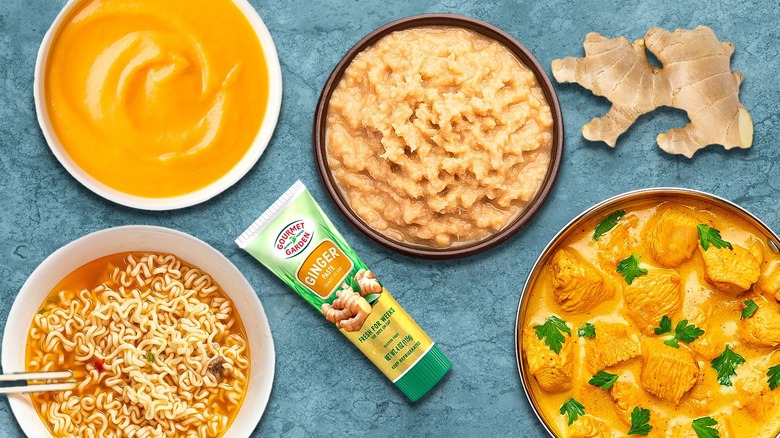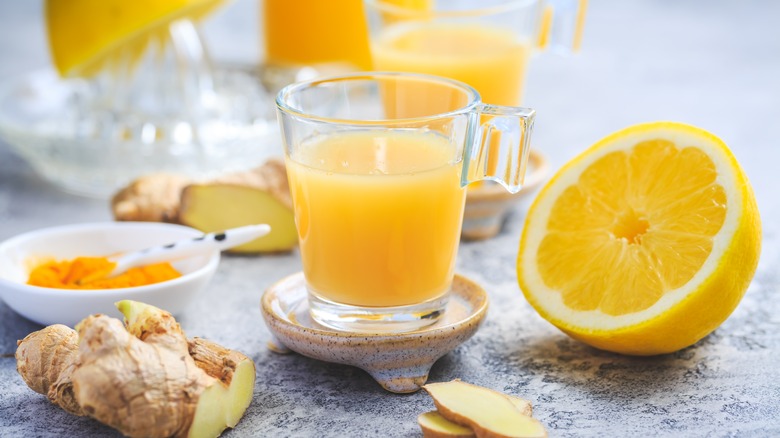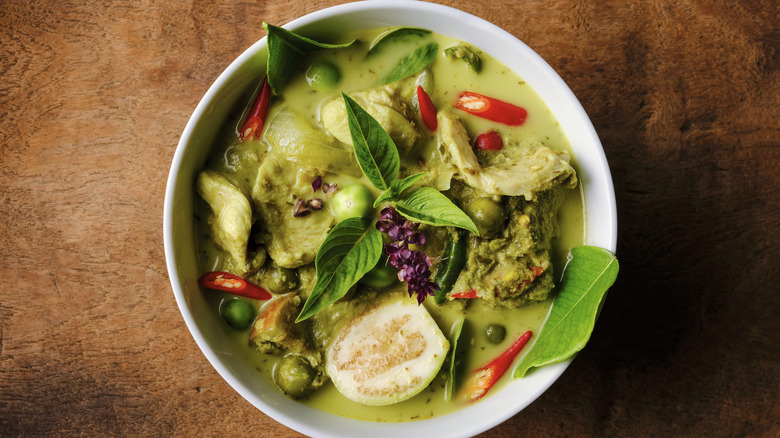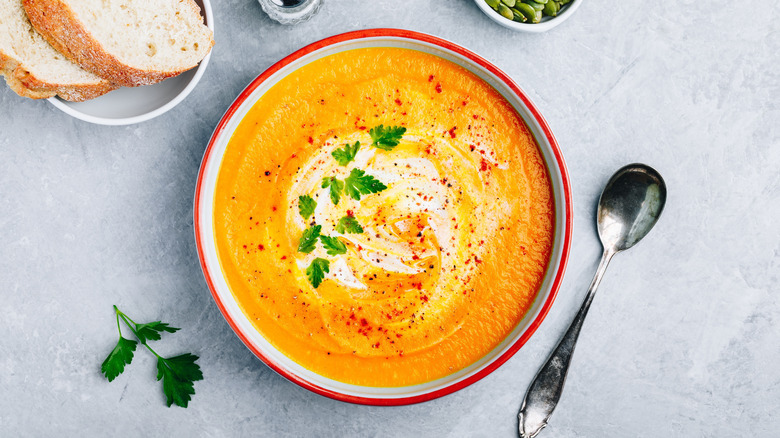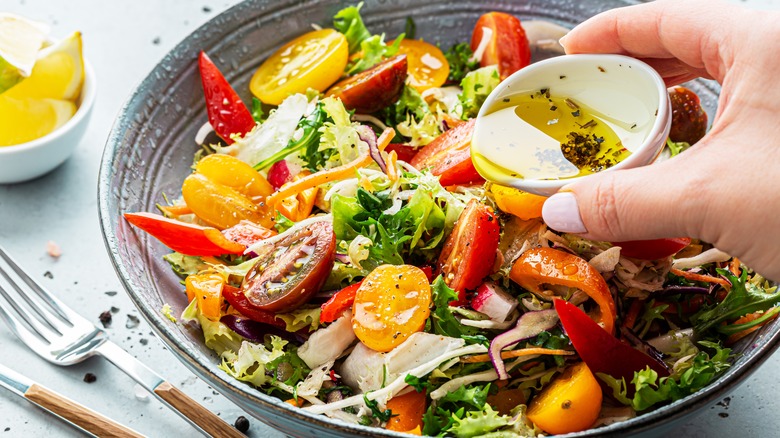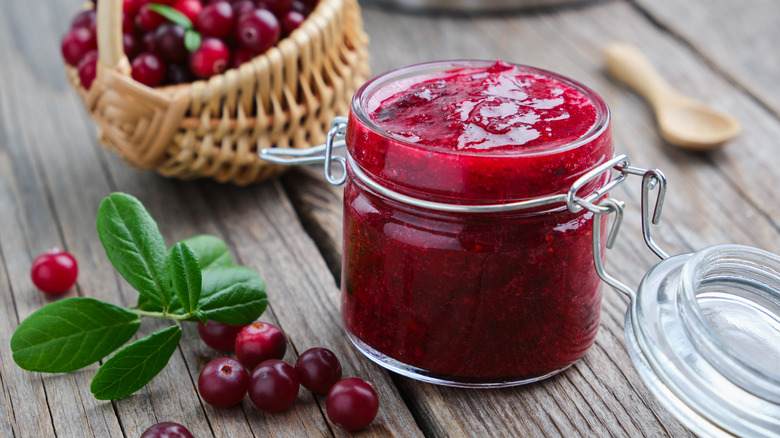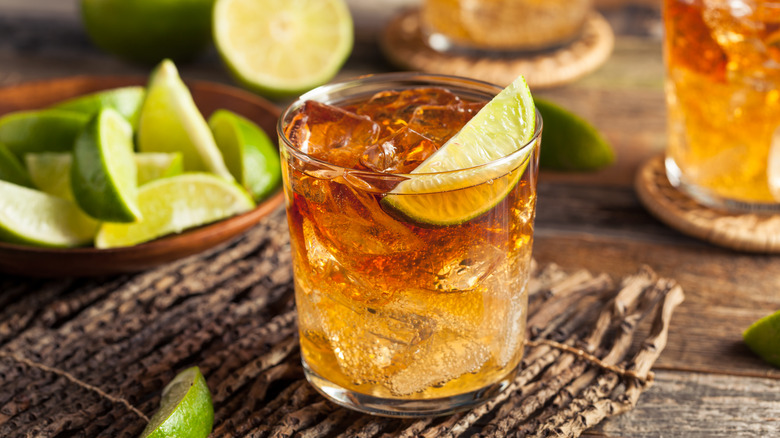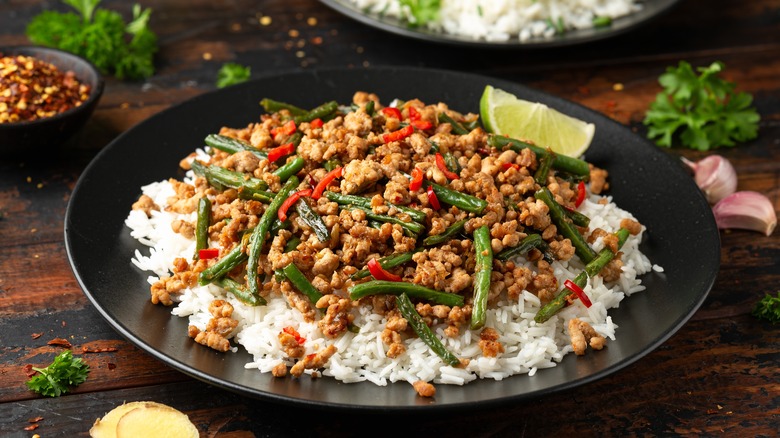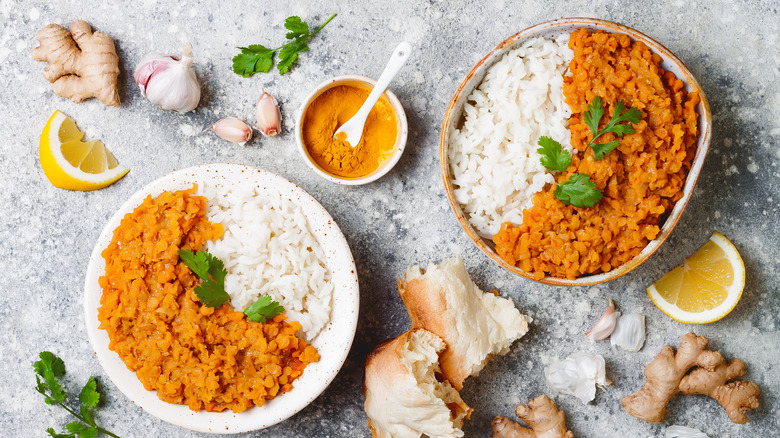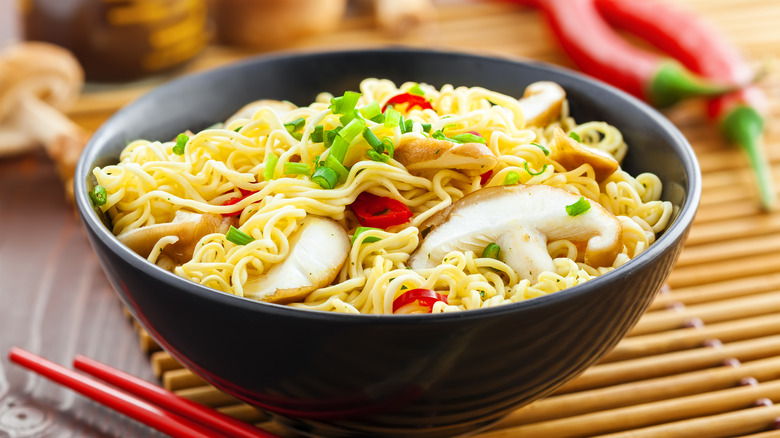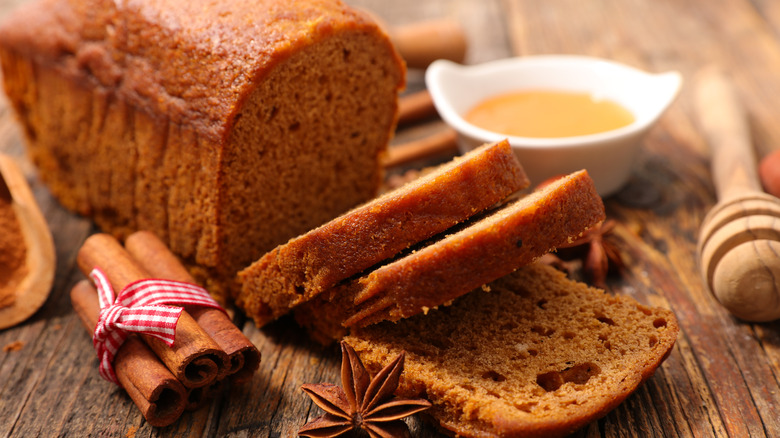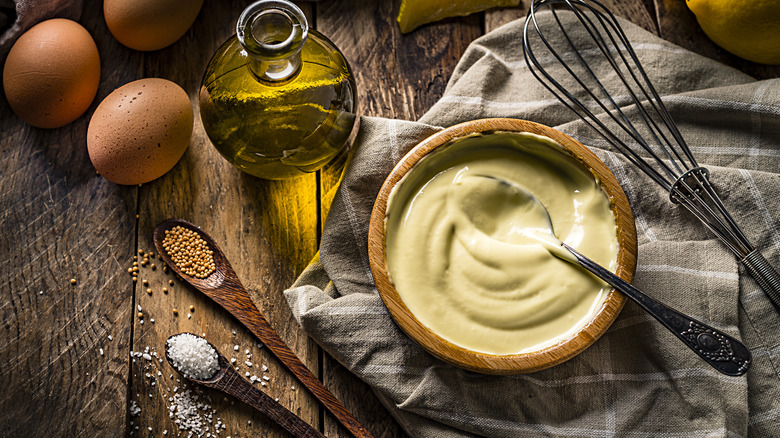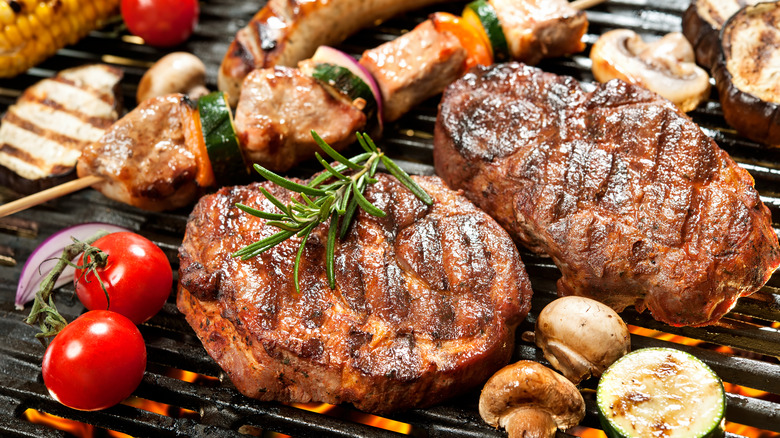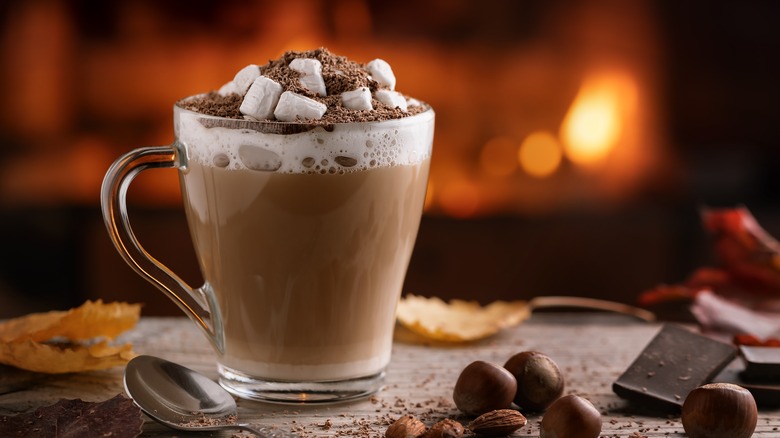14 Ways To Use Up That Tube Of Ginger Paste
We could sing the praises of ginger paste. For starters, it's so much more convenient than fresh — it lasts longer and requires no prep work, as opposed to carefully peeling then mincing the fibrous roots — which is a life-saver for people with disabilities and a tremendous advantage for anyone who doesn't have time to be leisurely in the kitchen. It may be less potent than dried ginger, yet it still packs a punch in the flavor department.
However, since most recipes call for fresh or dried ginger, it's not unusual to buy the paste for just one recipe and then forget about it — or to wonder how and when you should use the labor-saving ingredient. If that sounds like you, get ready for some inspirational ideas for not just mains but also desserts and drinks. Soon, you'll finish the old ginger paste and vie for more to try out all these suggestions. Excited?
Blend up some ginger wellness shots
Say goodbye to a morning cup of coffee and tea — ginger wellness shots are here to stay. The most basic interpretation of the wholesome elixir involves mixing the punchy juices of fresh ginger root with citrus flavors (typically lemon or orange juice). Other prevalent additions involve adding turmeric powder and coconut water, both of which help to mellow the flavor, besides boasting additional advantages. For example, ginger contains enzymes that help with stomach upset, plus anti-inflammatory and antibiotic properties that promote a healthy immune system. The supplementary ingredients boost the effects of ginger; orange juice contains high levels of vitamin C, aiding in bone and skin health, while turmeric has powerful antioxidant and anti-inflammatory bonuses.
While it may seem unconventional, opting for ginger paste instead of the fresh root streamlines the entire process; stir the paste into the other ingredients, and you're ready to go. It's important to note, however, that some brands of ginger paste may contain citric acid as a preservative, so it's advisable to account for the extra acidity by adding slightly less lemon or orange juice. Furthermore, since each ginger shot will only add a tiny amount of ginger paste, we recommend making large batches and freezing the mixture in ice cubes, so the ginger shot is ready to give you a quick boost in the morning, whenever you need it.
Add it to homemade curry paste
The characteristic warming, fiery, and decidedly spicy flavor of ginger lends itself wonderfully to the complex, bold flavors of curry dishes. For instance, if you've ever set out to make homemade green Thai curry paste, you'll notice it usually requires plenty of fresh ginger root, along with other fragrant additions like coriander, cumin, garlic, lemongrass, lime leaves, and much more. More stringently authentic Southeast Asian recipes may call for galangal, a variety of culinary ginger favored for its citrusy taste, but what if you don't have either galangal or fresh ginger root? The answer, of course, is ginger paste.
You can add a squeeze of ginger paste to any curry paste: rendang, Panang, or massaman curry are just a few examples. This substitution works just as well with other cuisines, such as Japanese kari (curry), Chinese takeout-style dishes, or even Indian meals — although the latter uses a different technique, so more on that later.
We advise adding more ginger paste than the recipe suggests, as the paste sometimes lacks the raw zestiness and vibrancy that fresh ginger introduces. On the flip side, curry is an ideal dish to use ginger paste, as the slight difference in flavor intensity is less noticeable amongst the other elaborately layered flavors.
Mix it into carrot soup
Few ingredients compliment each other quite as well as carrot and ginger. The gorgeously sweet flavors of roasted carrots play well with the warm spice of ginger, and although there are so many ways to incorporate that flavor combination into your meals — as a homely side dish for Sunday roast, for example — carrot and ginger soup is our all-time favorite and a real crowd pleaser.
You can make this dish as straightforward or complex as you like. Either start by roasting the carrots with onions then build the flavors with vegetable stock, garlic, and ginger paste added directly to the cooking pot, resulting in a far more striking flavor, or keep things classic by slowly sweating off the aromatics and spices in a pot, then add the carrots. If you choose to fry the ginger paste, be careful it doesn't catch, as this can quickly ruin your meal. It's also common for more watery brands to spit ferociously when added to oil, so always exercise caution and use a deep pan over low heat.
Depending on whether you want the ginger to stand out prominently in the soup, on par with the carrots, or prefer a more subtle hint, this is a wonderful way to use heaps of ginger paste. As a bonus, carrot and ginger soup is an excellent option for meal prep and bulk freezing, meaning you can easily use a whole tube.
Impress with a batch of homemade ginger ale
Don't be fooled by the name. Ginger ale is 100% non-alcoholic, which has several benefits: Firstly, there's no need to wait over a month for the beverage to ferment, unlike traditional ale, and secondly, it's appropriate for all, regardless of age or religion. But, we're overlooking its quintessential sweet, spicy, and sour refreshing flavor, which is enough to convince us to whip up a quick batch.
The process couldn't be any more effortless. While cooks usually infuse water with freshly grated ginger, we suggest you go ahead and stir the ginger paste into the water, then let it gently simmer, saturating the water with a spicy kick. Depending on the brand of ginger paste, you may need to run the infused water through a sieve for a completely smooth texture. All that's left is to make a simple syrup with equal amounts of water and sugar, then mix everything with soda (sparkling water). You can adjust the amount of ginger paste you use depending on how spicy you like your ale.
Whip up a quick salad dressing
Have you ever thought about using ginger paste in salad dressing? Unfortunately, salad has a reputation for being a boring healthy food — but if you know how to jazz up a salad beyond limp iceberg lettuce, basic sliced tomatoes, and cucumber, that's thankfully not reality.
One of our favorite ways to add excitement to salads guaranteed to be the talk of the dinner table (and perfect for potlucks, too) is by adding a squeeze of ginger paste. This Mongolian beef salad with a ginger lime vinaigrette epitomizes the idea of an inspiring salad fit to be a main course, with a fiery, salty, and tangy Asian-inspired dressing. Alternatively, if you fancy something a touch lighter, this kale and corn salad uses a refreshing, bright, and citrusy ginger lime dressing to add interest to the summery vegetarian ingredients. However, the sky is the limit; there's no need to limit yourself to these recipes. Let your imagination take hold and whisk some ginger paste into any dressing you fancy.
There are benefits to using ginger paste in a salad dressing, too. As opposed to the uneven distribution of even finely grated ginger, ginger paste will emulsify with the fats, sauces, and other flavorings in the dressing, evenly coating every element of the salads. It's ideal if you like a uniform flavor, with the added benefit of being less cumbersome.
Add a kick to homemade fruit-based sauces
Sometimes, it's not the main dish that steals the show; it's the accompaniments. Notably, sauces are the easiest way to transform even the most simplistic mains or desserts into restaurant-worthy plates. Here's a simple yet effective tip to ensure your sauces receive rave reviews: Integrate a hint of ginger paste.
For the ultimate all-rounder, consider putting a spin on your cranberry sauce by adding ginger paste, amplifying the sweetness, tang, and vibrancy. Of course, ginger-laced cranberry sauce is a natural pairing with braised pork or juicy turkey, but it also pairs well with cheese; savory dishes like grilled cheese or a layered cranberry cheesecake both work equally. If you want to lean on the sweet side, consider cranberry sauce swirled cake or pie filling — and why not up the ante by throwing in pieces of crystalized ginger too?
Thinking further out of the box, play on the flavors of five spice by squeezing some ginger paste into homemade Chinese plum sauce with roasted duck, or lather up your breakfast toast with a thick, ginger-scented fig jam. These are purely introductory ideas, but your creativity knows no bounds.
Play around with ginger-spiced cocktails
Would you believe us if we told you the best thing you could do for your potential reputation as the best mixologist in town is to use that tube of ginger paste? It could be the missing ingredient needed to make your homemade cocktails stand out.
We're huge advocates of using ginger-flavored simple syrup to give cocktails a spicy kick. To make this essential mix-in, whisk ginger paste into equal amounts of sugar and water, then cook on low heat until the sugar dissolves. It makes an excellent foundation for timeless favorites like a Moscow mule or a stiff ginger old-fashioned. Moreover, the spiced syrup is endlessly adaptive; fans of whiskey, gin, brandy, bourbon, vodka, or tequila will each enjoy the sweet-spicy twist.
There's no need for non-alcoholic mocktails to sit this movement out, either. The fiery nature of ginger simple syrup is a piquant match for the burning fizz of sparkling drinks like lemonade, perfectly harmonizes with tart, fruity flavors, and even adds fire to cooling tropical concoctions with coconut, lime, and cucumber.
Stir-fry protein with ginger for extra flavor
If you haven't tried incorporating ginger paste into your stir-fries, you're missing out on bags of flavor. It not only maximizes the potential of this versatile ingredient but also elevates your quick and easy weekday meals to an unprecedented level of goodness.
Here's how to infuse your dish with the zippy flavor of ginger paste: Blend it into a robust stir-fry sauce along with savory soy, umami-packed oyster sauce, sesame oil, creamy nut butter, and a touch of honey for sweetness. Sear your proteins, then pour in the stir-fry sauce, allowing the flavors to meld together and penetrate the protein. Alternatively, kickstart your dish by sautéing ginger paste with oil, shallots or onions, garlic, and chilis before adding the protein. This method tones down the pungency of ginger paste, highlighting its mellower, warm notes.
Perhaps the best thing about this idea is it's completely adaptable to your tastes. You can use any protein you like — crowd-pleasing chicken, plant-based tofu, nutty tempeh, savory beef, pork, or a medley of fresh vegetables (surprisingly, edamame is a brilliant source of protein) — and take inspiration from any cuisine. We're talking everything from Thai ginger pork bowls to classic Chinese beef and broccoli.
Incorporate it into Indian curries and dals
As we've already established, ginger pairs naturally with highly spiced foods, particularly curry. And which country is renowned for its curry dishes? India. Of course, Indian cuisine spans far beyond just "curries." However, whether it's a must-try Indian breakfast, lentil dishes (dal), or moreish street food picks, there's a common thread: Ginger, along with onion and garlic, finds its way into almost everything.
Unlike other cuisines, many Indian dishes don't utilize a premade curry paste, instead following a process of gently sautéing whole spices, aromatics (like onion, garlic, and ginger), and dry spices in oil before adding the vegetables or protein. Interestingly, many authentic Indian recipes call for premade, store-bought ginger paste, so adding the punchy paste to your meals might be more traditional than you first thought.
Depending on the recipe, you'll want to combine your ginger paste with garlic paste in equal parts or use the ginger paste alone. Whichever method you opt for, incorporate the flavorful paste into your dish after adding onions to prevent it from sticking to the pan and burning. It infuses a consistent, comforting warmth throughout the bowls.
Elevate your instant ramen
Even the best cooks have days when cooking is too daunting. Whether it's stress, exhaustion, illness, or a combination of all three making at-home cooking impossible, it's easy to cave and buy takeout. But, most of us have a stock of instant ramen tucked away for occasions like this: When we need a low-effort, fulfilling meal that delivers just as much taste as nostalgia.
While social media is awash with ideas suggesting how to transform instant ramen into a gourmet experience — from carbonara-style to cheesy Korean tteokbokki mixed with spicy ramen noodles, there are countless ways to upgrade instant ramen — here's one hack that rarely gets mentioned, and the best part? No extra chopping is required. Now, that sounds like a win-win to us.
All you need to do is add a liberal squeeze of ginger paste to the packet of ramen broth and mix well to give your ramen a monumental flavor boost with minimal exertion. The ginger will melt into the ramen broth, adding a robust kick and tempting aroma to the bowl. There's no need to do anything more, but if you're feeling fancy, you can add a squeeze of lime juice and a sprinkling of scallions, both of which beautifully match the dynamic flavors of ginger.
Add warmth to baked goods
Ginger has been a beloved flavor in desserts for as long as we can remember. Gingersnap biscuits, sticky ginger pudding, gingerbread houses, and Jamaican ginger cake are just a few of the ginger-flavored treats we know and love.
At first, the idea of adding ginger paste to baked goods may sound bizarre. Nevertheless, it works — after all, ginger paste isn't much different from freshly minced ginger or dried ground ginger. There are only two things you should consider: Firstly, ginger paste introduces more moisture to recipes, so account for this in your baking, and secondly, the paste is the least potent of all the varieties, so you may need to add more to achieve an assertive flavor.
For the best results, mix your ginger paste with the wet ingredients (like egg, milk, or oil) and pair with complimentary flavors. We suggest fruit-based dishes like this ginger and pear crisp crumble, ginger and apple pie, or a berry and ginger cobbler. Alternatively, consider exploring dishes that complement ginger's flavor profile. For instance, you might find inspiration in recipes featuring ingredients like molasses, chocolate, cinnamon, or allspice, all of which have a rich, deep undertone.
Create an incredible dipping sauce by mixing it with mayo
Mayonnaise is an incredibly versatile condiment. Whether you serve it with fries, in-between burger buns, or mix it into a creamy potato salad, it's hard not to love the thick and creamy sauce. Only one thing can make it better: add-ins. At its heart, mayonnaise is a basic recipe with less than three ingredients, so there's plenty of room to add extra flavor. Burger sauce — a combination of piquant ketchup, creamy mayonnaise, and sharp mustard — is an obvious example, but ginger mayo is a crucial recipe to have in your arsenal. It effortlessly enhances meals without overshadowing the main dish, making it perfect for accommodating varying spice tolerances among diners.
To make a spicy ginger mayo, emulsify the fiery paste into the other ingredients or stir it into store-bought mayonnaise. To up the ante even further, why not add a size of citrus, a dab of wasabi, or a squirt of umami-rich soy sauce? We love using the relish as a dipping sauce for crispy karaage chicken, drizzling it on top of sushi, or smothering burger buns.
Make a rub or marinade for grilling meats
If you're an expert at the grill, you likely already have a jar of smoky, zesty dry rub hiding in your cupboard for family cookouts and barbecues. If not, now is the perfect time to mix one up.
Ginger paste works excellently to build flavor in spice rubs. Of course, a dry rub usually uses powered spices — but rubbing the meat with a ginger paste mixed with oil helps the spices stick. Alternatively, ginger paste brings exceptional flavor and tenderness to dishes requiring a wet rub, like brisket, ribs, or pulled pork. Despite ginger paste not being a traditional addition, it complements the distinctively sweet, spicy, and aromatic flavor of smoked meats astonishingly well — so well that you might find yourself adding ginger paste every time.
Moreover, ginger paste is a conventional addition to marinades for dishes like tandoori prawns or paneer tikka in the South Asian subcontinent. While yogurt or another acidic element tenderizes the protein, the strength of the ginger paste, often combined with garlic, suffuses the protein, building complex layers of flavor before it even hits the grill (or tandoor).
Infuse your hot chocolate with warming spice
There are numerous ways to cook with spices, and, funnily enough, some don't involve cooking at all — for example, spices can upgrade any drink, from cocktails to lemonade. But have you ever considered adding spices to hot chocolate? Of course, we're specifically referring to ginger, with its warm and spicy undertones that beautifully complement the fruity, earthy, and rich flavors found in chocolate. Because we usually enjoy hot chocolate in the colder months, when snow is falling or chill winds are blowing, the innate heat of ginger hot chocolate helps us feel warm and cozy.
Cooks generally make ginger-spiced hot chocolate with dried ground ginger, which has a much stronger flavor, but we still don't recommend using much of the ginger paste. You'll also need to make the hot chocolate from scratch, as we'll infuse the ginger into the milk before adding chocolate and cocoa powder. If you like, add some other complimentary spices and grab a pack of gingerbread biscuits to dip into the hot chocolate — or crush them over the obligatory topping of whipped cream and marshmallows.
